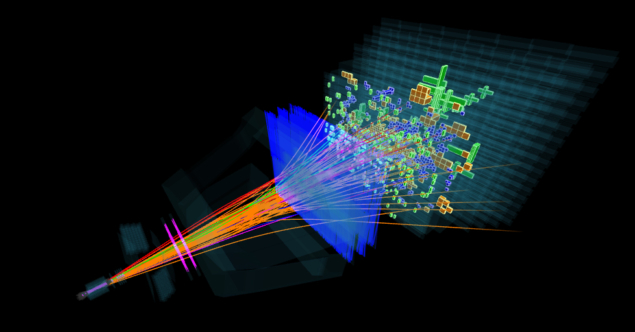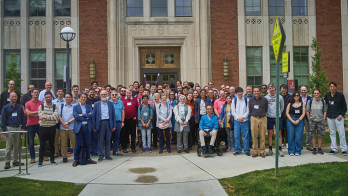
LHCb has launched a new offensive in the exploration of lepton-flavour universality – the principle that the weak interaction couples to electrons, muons and tau leptons equally. Following previous results that hinted that e+e– pairs might be produced at a greater rate than μ+μ– pairs in B-meson decays involving the b→sℓ+ℓ– transition (ℓ=e,μ), the study brings b-baryon decays to bear on the subject for the first time.
“LHCb certainly deserves to be congratulated on this nontrivial measurement,” said Jure Zupan of the University of Cincinnati, in the US. “It is very important that LHCb is trying to measure the same quark level transition b→sℓ+ℓ– with as many hadronic probes as possible. Though baryon decays are more difficult to interpret, the Standard Model prediction of equal rates is very clean and any significant deviation would mean the discovery of new physics.”
We are living in exciting but somewhat confusing times
Jure Zupan
The current intrigue began in 2014, when LHCb observed the ratio of B+→K+μ+μ– to B+→K+e+e– decays to be 2.6σ below unity – the so-called RK anomaly. The measurement was updated this year to be closer to unity, but with reduced errors the significance of the deviation – either a muon deficit or an electron surplus – remains almost unchanged at 2.5σ. The puzzle deepened in 2017 when LHCb measured the rate of B0→K*0μ+μ– relative to B0→K*0e+e– to be more than 2σ below unity in two adjacent kinematic bins – the RK* anomaly. In the same period, measurements of decays to D mesons by LHCb and the B-factory experiments BaBar and Belle consistently hinted that the b→cℓ–ν̄ℓ transition might occur at a greater rate for tau leptons relative to electrons and muons than expected in the Standard Model.
Baryons enter the fray
Now, in a preprint published on 18 December, the LHCb collaboration reports a measurement of the ratio of branching fractions for the highly suppressed baryonic decays Λb0→pK–e+e– and Λb0→pK–μ+μ– to be RpK-1 = 1.17+0.18-0.16 (stat) ± 0.07 (syst). The reciprocal ratio to that reported for the B-meson decays, the measurement is consistent with previous LHCb measurements in that it errs on the side of fewer b→sμ+μ– than b→se+e– transitions, though with no statistical significance for that hypothesis at the present time. The blind analysis was performed for an invariant mass squared of the lepton pairs ranging from 0.1 to 6.0 GeV2 – well below contributions from resonant J/ψ→ℓ+ℓ–, with observations of the latter reaction used to drive down systematics related to the different experimental treatment of muons and electrons. J/ψ meson decays to μ+μ– and e+e– pairs are known to respect lepton universality at the 0.4% level.
“It’s very satisfying to have been able to make this lepton-flavour universality test with baryons – having access to the Run 2 data was key,” said analyst Yasmine Amhis of the Laboratoire de l’Accélérateur Linéaire in Orsay. The analysis, which also constitutes the first observation of the decay Λb0→pK–e+e–, exploits an integrated 4.7 fb-1 of data collected at 7, 8 and 13 TeV. “LHCb is also working on other tests of the flavour anomalies, such as an angular analysis of B0→K*0μ+μ–, and updates of the lepton-flavour universality tests of RK and RK* to the full Run 2 dataset,” continued Amhis. “We’re excited to find out whether the pattern of anomalies stays or fades away.”
We’re excited to find out whether the pattern of anomalies stays or fades away
Yasmine Amhis
An important verification of the B-meson anomalies will be performed by the recently launched Belle II experiment, though it is not expected to weigh in on Λb0 decays, says Zupan. “I think it is fair to say that it is only after both Belle II and LHCb are able to confirm the anomalies that new physics will be established,” he says. “Right now, we are living in exciting but somewhat confusing times: is the neutral-current b→sℓ+ℓ– anomaly real? Is the charged-current b→cℓ–ν̄ℓ anomaly real? Are they connected? Only time will tell.”
Further reading
LHCb Collaboration 2019 arXiv:1912.08139
LHCb Collaboration 2019 Phys. Rev. Lett. 122 191801 [arXiv:1903.09252]
LHCb Collaboration 2017 JHEP 08 055 [arXiv:1705.05802]
LHCb Collaboration 2014 Phys. Rev. Lett. 113 151601 [arXiv:1406.6482]








